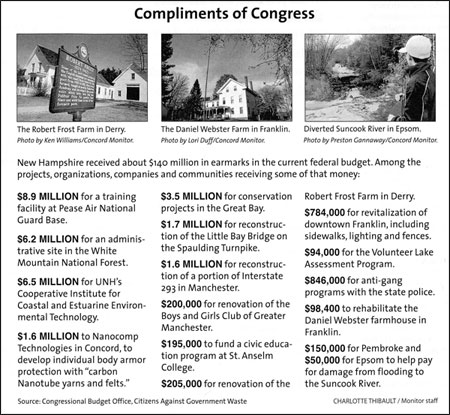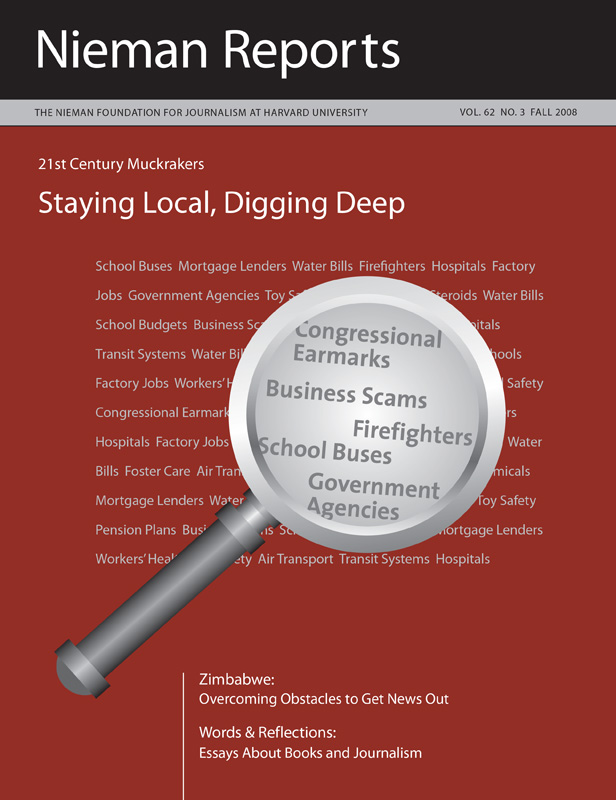When The Associated Press Managing Editors (APME) seriously began discussing the prospect of its first-ever national reporting project in the summer of 2007, the newspaper industry was struggling, but it didn’t feel like it was searching for its soul. Today, it is being dismantled at breathtaking speed. And those of us left must ask: Who RELATED ARTICLE
In the Spring 2008 issue of Nieman Reports, Brazilian journalist Fernando Rodrigues wrote about a similar collaborative model of investigative reporting undertaken on a global scale.
Read his article, “Global Efforts at Investigative Reporting” »are we? What are we attempting to do? Why does it matter?
Through a national investigative reporting project—focused on earmarks loaded into the federal budget and collaboratively undertaken by 75 newspapers—a few answers have begun to emerge. As a consequence of this project, APME leadership decided to forge partnerships with open government foundations as a way to produce high-quality public service journalism in smaller newspaper markets throughout the country.
Our intent with this initial effort was to tell an important story by helping reporters find the connective threads between earmarked requests, the flow of money, and influence in the legislative process. In fiscal year 2008, earmarks loaded into bills were worth $18.3 billion, and most were tantamount to no-bid contracts. In explaining how the system works—for recipient and legislator—we provided readers valuable watchdog reporting.
We also created a potential model for investigative journalism, one that weaves together the newsroom needs and skills of smaller market papers to create a story that some news organizations could not do on their own.And what we’ve learned might be of help to newspapers as they struggle through their darkest financial chapter since the Great Depression.
In this project, newspaper reporters joined forces with our nonprofit partners—Taxpayers for Common Sense, the Sunlight Foundation and, of course, The Associated Press (AP), which has worked with newspapers since its inception in 1846. Here is a glimpse at the role each of these partners played:
- Taxpayers for Common Sense sifted, sorted and made sense out of a series of very large federal databases. Their efforts helped reporters connect the dots between earmarks and campaign contributions from lobbying firms and businesses to members of Congress.
- The Sunlight Foundation organized and oversaw free six-hour training sessions in 13 cities across the country to show reporters and editors how best to harvest information. It also conducted two lengthy Webinars for those who couldn’t get to a classroom. More than 220 reporters and editors from 150 news organizations participated.
- The Associated Press writers and editors played an invaluable role by taking the information that had been gathered by reporters working at local newspapers and then producing analysis pieces imbued with historical perspective. This collaborative effort placed the local investigative reporting into a broader national context.
EDITOR’S NOTE
A project overview and links to specific articles that appeared in local papers can be found at www.apme.com/
earmarks/Each of the partners played an essential role in gathering and analyzing information about Congressional earmarks. Once assembled, this information—tailored to the interests of local readers and written in different styles and with varying emphasis—appeared in newspapers scattered throughout the country on a weekend in early June.
In The Herald in Monterey (Calif.) County, staff writer Julia Reynolds began her article, called “Bringing Home the Bacon,” by focusing on the local Congressman.
Rep. Sam Farr says he doesn’t think the public understands pork. At least not the legislative kind.
In fact, Farr—a Democrat who has been voted “porker of the month” by a taxpayers’ group and is regularly derided by Republicans for bringing millions in federal funds to the Central Coast—vigorously defends legislators’ use of the earmark system to bring home the bacon.
“I’m on the appropriations committee, and I’m there to represent Monterey, Santa Cruz, and San Benito counties,” he said. “I’m glad to argue with anyone about it.”
RELATED GRAPHIC
See “Compliments pf Congress” below »In the Concord (N.H.) Monitor, reporter Daniel Barrick took a different approach in his article, “Are state’s earmarks wasteful? You decide.”
Franklin’s sidewalks. Robert Frost’s farmhouse. The Mount Washington Observatory. A Nashua engineering firm. What do they have in common? All benefited from spending requests tucked into the current federal budget.
Those weren’t the only beneficiaries of so-called “earmark” spending in New Hampshire. Dozens of companies, nonprofit groups, and communities across the state received millions of dollars in federal cash this year, thanks to requests from the state’s four members of Congress.
Lessons Learned, Future Directions
Newspaper editors involved with this project tell me that it helped their reporters produce good work that hit with pinpoint accuracy. What their staffs learned will have long-range impact on these papers’ ability to do sophisticated database journalism. And the interactive links set up on the newspapers’ Web sites give readers the opportunity to experience for themselves how the earmark game is played in Washington, based on searchable databases prepared by Taxpayers for Common Sense. These databases contain information about the 13,000 earmark items in the 2008 fiscal budget. Susan M. Catron, executive editor of the Savannah (Ga.) Morning News, whose team went to Atlanta for training, describes this opportunity as “golden.”
APME, AP, and Sunlight are planning to collaborate on another public service project in 2009. APME operates under the same strict ethical guidelines as does AP, and we’re careful about selecting partners. When partnerships are carefully structured with groups such as Taxpayers for Common Sense and the Sunlight Foundation, whose missions revolve around openness in government, I see the combined efforts of foundations such as these and news organizations being a potential force in producing solid watchdog journalism. As the newspaper industry experiences wave after wave of staff cuts after each disappointing earnings report, we need to become more inventive, and sometimes that entails taking risks.
By using a model like this one, we can more effectively use our staff to do investigative journalism that holds government institutions accountable.
At the same time, editors at the barricades could use some help from the industry’s leaders, who’ve been searching a long time for a business model to sustain what journalists do. With our print, online and niche readership numbers combined, so-called old media now reaches a larger audience share than ever before. Yet a financial solvency isn’t on the horizon.
As newspapers soldier on in search of such a new profitable model, journalism groups like APME will continue to forge partnerships with foundations to enrich the experience for readers. Ryan Alexander, president of Taxpayers for Common Sense, sees promise in what’s been done. “We can put together data sets, but they are so much more amplified when the work is shared with citizens [through projects like investigating earmarks]. There’s a benefit for everyone.” Ellen Miller, executive director and cofounder of the Sunlight Foundation, sees this kind of partnership as being essential to maintaining a healthy democracy—in part because it is apparent that newspapers, traditionally the nation’s most effective watchdog, need help. “Sunlight firmly believes in supporting the future of journalism,” adds Miller.
Kathleen Carroll, executive editor of AP, observed that “The earmarks project is the kind of journalistic work that helps readers understand how well the officials they elect are serving them. On the right topics, these kinds of reporting partnerships between AP and APME member newspapers deliver critical information to taxpayers—exactly what news organizations should be doing.”
The industry is being forced to reinvent itself. Those left standing need to stop talking about what we used to be and focus on what we can be. We’re no longer fighting to breathe life into a dying business model of words delivered only on the printed page.
We’re in this fight to preserve journalism—which, as this project reminds us, is a fight to preserve investigative storytelling that strengthens our democracy.

David Ledford is vice president for news and executive editor of The News Journal in Wilmington, Delaware. He also is president of the Associated Press Managing Editors group.


